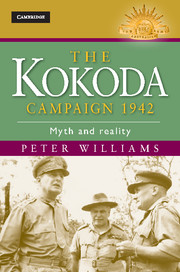Book contents
- Frontmatter
- Contents
- Photographs
- Maps
- Tables
- Key to military symbols
- Acknowledgements
- Note on the text
- Glossary
- Chapter 1 Introduction
- Chapter 2 Strategy
- Chapter 3 Military intelligence
- Chapter 4 The Nankai Shitai
- Chapter 5 From the landing to Deniki
- Chapter 6 Isurava
- Chapter 7 Guadalcanal and Milne Bay
- Chapter 8 The Japanese build-up
- Chapter 9 First Eora–Templeton’s
- Chapter 10 Efogi
- Chapter 11 Ioribaiwa
- Chapter 12 Japanese Artillery
- Chapter 13 Malaria and dysentery
- Chapter 14 The Japanese supply crisis
- Chapter 15 Second Eora–Templeton’s
- Chapter 16 Oivi–Gorari
- Chapter 17 The war in the air
- Chapter 18 Conclusion
- Note on sources
- Notes
- Bibliography
- Index
Chapter 14 - The Japanese supply crisis
Published online by Cambridge University Press: 05 November 2013
- Frontmatter
- Contents
- Photographs
- Maps
- Tables
- Key to military symbols
- Acknowledgements
- Note on the text
- Glossary
- Chapter 1 Introduction
- Chapter 2 Strategy
- Chapter 3 Military intelligence
- Chapter 4 The Nankai Shitai
- Chapter 5 From the landing to Deniki
- Chapter 6 Isurava
- Chapter 7 Guadalcanal and Milne Bay
- Chapter 8 The Japanese build-up
- Chapter 9 First Eora–Templeton’s
- Chapter 10 Efogi
- Chapter 11 Ioribaiwa
- Chapter 12 Japanese Artillery
- Chapter 13 Malaria and dysentery
- Chapter 14 The Japanese supply crisis
- Chapter 15 Second Eora–Templeton’s
- Chapter 16 Oivi–Gorari
- Chapter 17 The war in the air
- Chapter 18 Conclusion
- Note on sources
- Notes
- Bibliography
- Index
Summary
According to the Kokoda myth, the Japanese turned back at Ioribaiwa because they ran out of food, and for the remainder of the Kokoda campaign they were starving. The myth explains that the Japanese did not bring enough food with them as they intended a rapid advance to Port Moresby. When the advance was slowed by Australian resistance they went hungry. We have already seen that this is incorrect. Enough food was brought to Papua where a regular, although less than generous, supply system was put in place, and the plan for a rapid advance to take Port Moresby was abandoned at Isurava. There was, however, a Japanese supply crisis that began in mid-September and was at its height during the battle of Second Eora. It had little to do with supposedly inadequate preparation, lasted for less than six weeks before the problem was solved and was catastrophic for only a small portion of the Nankai Shitai: the Stanley Detachment, fewer than a thousand men of the 15 000-strong force. What happened to the Stanley Detachment has been thought to apply to the whole of the Nankai Shitai, or at least to the part of it that went south past Kokoda. A typical example appears in Ham’s Kokoda: ‘Captured diaries and documents dated towards the end of September portray an army slowly starving to death.’
- Type
- Chapter
- Information
- The Kokoda Campaign 1942Myth and Reality, pp. 171 - 184Publisher: Cambridge University PressPrint publication year: 2012



